
Lessons from the Trail | Part 2
By: Charlotte Staats - Adirondack Council's Clarence Petty Advocacy Intern
Monday, March 2, 2020
“Lessons from the Trail” is a blog series that discusses what the author, Charlotte Staats, has learned from living and working in the Adirondack Park. Charlotte Staats lives and recreates in the Adirondacks, and spent 5 seasons working on a backcountry trail crew that specializes in working in wilderness areas. The blog series will discuss her experience on trail crew, what she learned while working in backcountry settings, and the challenges she has seen facing the Adirondacks. (Missed Part 1? Check it out here.)
When I first applied to be on trail crew, I only knew what the job description summarized, and the stories my mom had told me. When I first started in 2015, I didn’t know much about trail work. Within my first few weeks on the job, I realized that there’s a lot to learn. I learned how labor intensive it is, how challenging packing in and out of a worksite can be (even after doing it for a season or two). By my fifth year, I knew exactly how hard my crew and I needed to work to be able to build beautiful, functional pieces of infrastructure, and how much experience is needed to be able to think about a project as a whole, and then break it down into manageable pieces for a crew to work on. I had learned how to delegate tasks in ways that efficiently kept a project progressing. I had also learned that there is no cut-and-dry method to trail work, and that you can always learn new ways to approach and build trail infrastructure. Today, I know that human-powered trail work takes time – more so than mechanized trail work. It takes time to gain the skills to safely and efficiently do trail work, and it takes experience to be able to build effective, long-lasting, high-quality trail infrastructure. A trail worker must employ the skills and experiences they’ve collected over time to be able to efficiently build anything in the backcountry, and be ready to adapt to whatever obstacles arise as projects progress.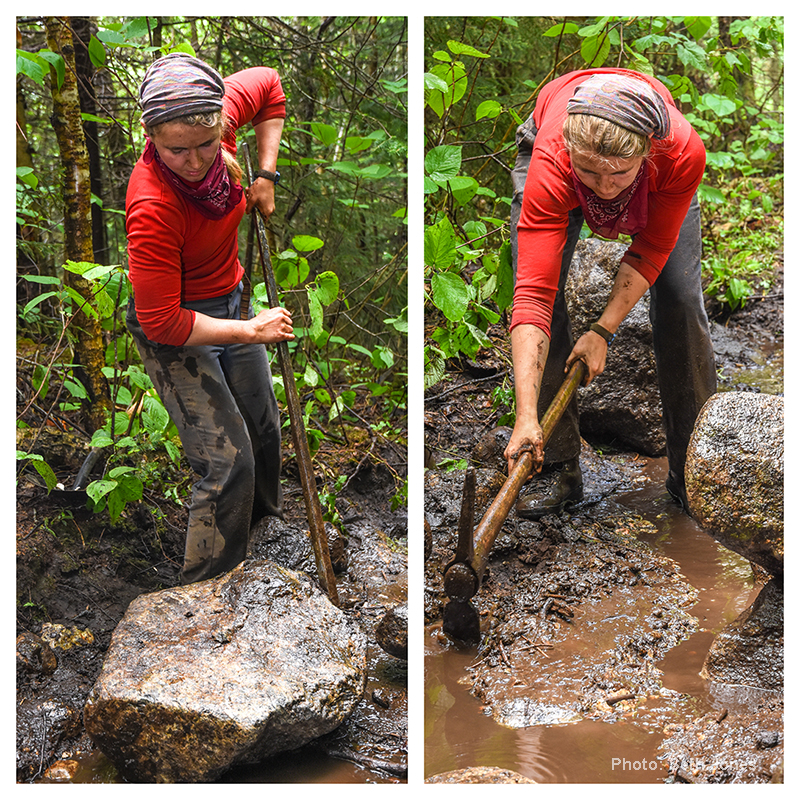 Left: Rock bars are an essential tool in trail work. Rock bars rely on a user's knowledge of physics and training to be able
Left: Rock bars are an essential tool in trail work. Rock bars rely on a user's knowledge of physics and training to be able
to move rocks efficiently. Right: Pick-mattocks and shovels are used to dig holes necessary to build trail infrastructure.
What is "Trail Crew?"
Trail crews are responsible for the construction, maintenance and rehabilitation of trails. There are trail crews for any kind of trail you can think of: hiking, biking, skiing, snowshoeing, and horse trails - the list goes on. I worked on the Adirondack Mountain Club’s (ADK) professional trail crew. There are trail crews wherever maintained trails are found. The Appalachian Mountain Club (AMC) and the Green Mountain Club (GMC) have trail crews, so do national parks throughout the country. ADK’s crew constructs, maintains and rehabilitates trails in and out of the Adirondack and Catskill Parks. What makes the Adirondack Park and our crew unique is the existence of land classified as “Wilderness.”
New York Forest Preserve lands that are designated as Wilderness prohibit the use of motorized equipment and vehicles. Trail crews must follow the rules and regulations of state land, just like everyone else. Adirondack Mountain Club’s trail crew specializes in working in backcountry wilderness settings, which means that we use traditional, non-motorized hand tools to create sustainable trail infrastructure. It also means that we must get to our project sites without motorized transport -- hiking to our destinations, regardless the distance.
Creating high-quality, long lasting trails and trail infrastructure by hand requires time, specialized skills, knowledge, and dedicated people determined to work extremely hard. It takes time and effort to fell a tree, process it and create bridging through a wetland or across a stream. In the same vein, finding, harvesting and using rocks to create a rock staircase, rock water bar, or rock turnpiking also takes time and effort. The process for building such structures can be slowed or expedited by the experience and skill set of crew members and their ability to work in a variety of changing conditions with evolving challenges.
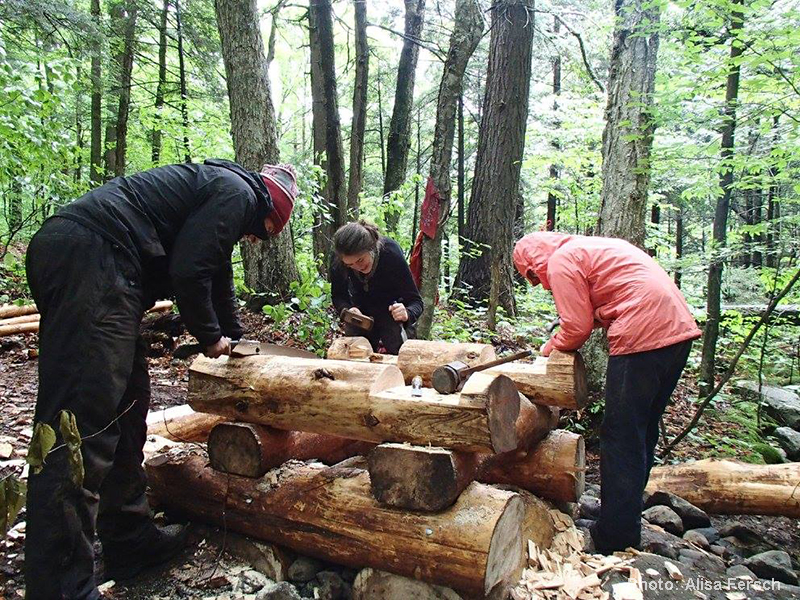 Trail workers are skilled at their crafts. Notching pieces of native timber is a skill that is honed over time.
Trail workers are skilled at their crafts. Notching pieces of native timber is a skill that is honed over time.
Trail Work Takes Time
In non-motorized trail work, everything takes more time. Trail workers use long, metal bars with a beveled end (called rock bars), pick-mattocks, and physics to move enormous rocks down a hillside to where work is being done. Sometimes, a crew will get lucky and a rock quarry (a term that designates the area, or areas, in which rocks are found and harvested for use) is easy and overflowing with desirable rocks to use. More often, this is not the case. It can be challenging to find rocks because they’re hidden and dispersed throughout the forest. Sometimes the quarry is far away. Other times, there are many obstacles between the quarry and the project site. Once a rock is at the project site, it takes time to dig the hole it will finally rest in, and once the rock is in the hole, it takes time to make sure it will never move again. This process is done for every rock that is used to build trail infrastructure.
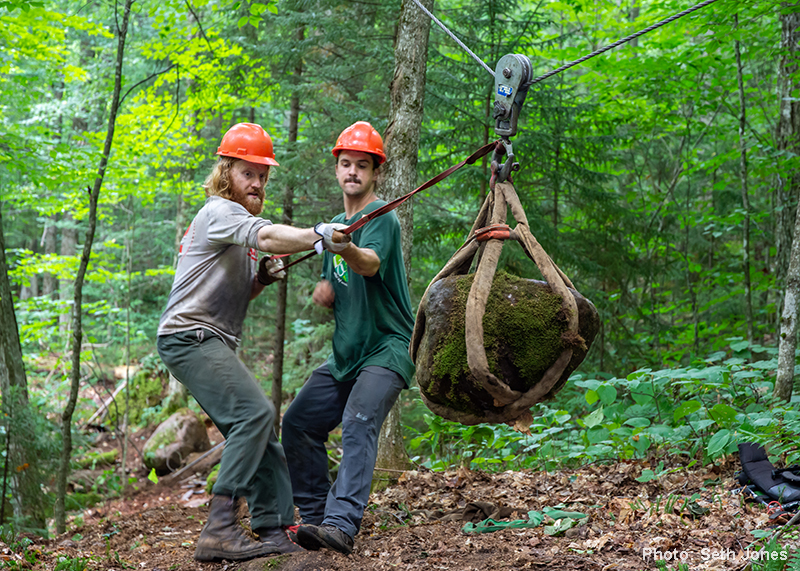 Two trail workers use a tool known as a grip-hoist system to move large rocks over difficult terrain. The set-up and
Two trail workers use a tool known as a grip-hoist system to move large rocks over difficult terrain. The set-up and
use of grip-hoist systems require training.
Wooden trail infrastructure, such as bog bridging, span bridges or ladders takes time to create too, regardless if the project is built with native timber or pressure treated lumber. Native timber (which is happening less and less) must be harvested and processed into the parts required to build a bridge: bark must be stripped, branches must be limbed, and the trunk must be bucked (cut) up into exact lengths. That’s only the beginning of the process. Once the tree (or trees) are cut into the right lengths, flat and level surfaces to fasten the bridge together and walking surfaces must be made using bow saws, chisels and axes.
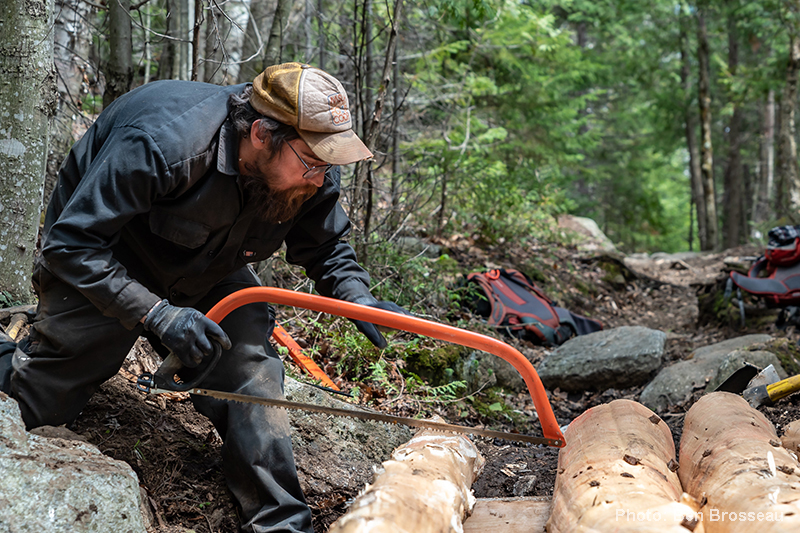 To create wooden trail infrastructure, native trees are harvested and turned into bridging for hikers using only hand-tools
To create wooden trail infrastructure, native trees are harvested and turned into bridging for hikers using only hand-tools
such as bow saws, chisels and axes.
When building with dimensional pressure-treated lumber, some of these steps are already done. However, dimensional lumber must be hauled to the project site from where it was dropped. My co-workers and I have hauled many 12-foot lengths of 6-inch by 6-inch lumber from the summit of Mount Colden to a mile down the trail in order to build wooden ladders. We’ve hauled even more lumber from Avalanche Lake through Avalanche Pass to build bog bridges. Even when these pieces of lumber are dry (they are usually water logged), their weight crushes you with every step you take to hike these materials to their final resting place. Cutting, chiseling and ensuring that everything is level, square and fastened takes time too. For ladder projects, holes must be hand-drilled into the bedrock slabs in order to secure the ladders to the surface.
Trail Work Takes Skill
Trail work is a skilled labor. The ability to use hand-tools and to create inviting, durable trails is something that must be taught. The techniques for using hand tools and the process of building different trail infrastructure has been passed down from crew member to crew member over the last four decades. Skills are built up over time with experience and exposure to a variety of projects and locations.
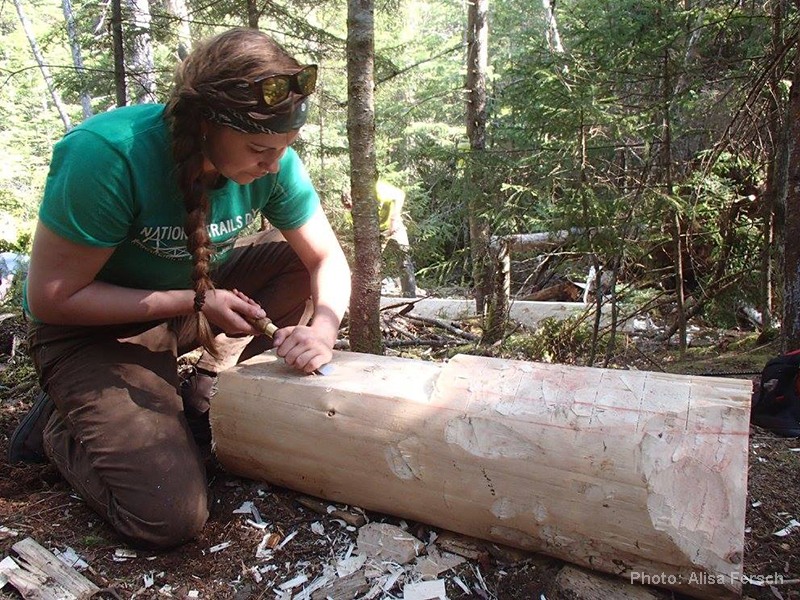 A trail crew member uses a chisel on to turn a piece of native timber into a flat surface in order to build bog bridges.
A trail crew member uses a chisel on to turn a piece of native timber into a flat surface in order to build bog bridges.
Basic skills can be taught when new crew members join, but high-level skills can only be learned over time. Most people can use a shovel, but a trail worker must know how to dig a hole that will keep a rock steady and unmoved for decades. The use of a rock bar to move impossibly large rocks is a skill that is finessed over time. Rocks can certainly be moved with sheer grit and will-power, but there are movements and techniques to save energy, effort and time that have quite a learning curve. With wooden infrastructure, it is a skill to safely and accurately harvest a tree and create flat, level walking surfaces with hand-tools. When creating a trail that cuts across a slope, it takes skill to create a walking surface that will shed water and hold-up to years of footsteps. Not only that, but it requires skill to know how to work and build infrastructure with the least amount of impact to the surrounding area. It is skill built over time to be able to use hand tools to create something that will stand up to the test of time in the Adirondacks.
Trail Work Takes Experience
An experienced trail worker is capable of taking seemingly impossible tasks and accomplishing them. Within the same mile of trail, the process and challenges of building infrastructure can differ. Local Adirondack environments vary, and the challenges that come with a project can evolve and change depending on the circumstances. A trail worker that can draw on experience, that can recall what has and hasn’t worked in the past, and analyze what methods can be used to resolve challenges that arise in the field. Experience and knowledge can only be gained from weeks of working with and watching crew leaders conquering the challenges that they face. Experience, or the presence of an experienced leader, makes a world of difference: it will save crews time and effort when working on projects, and make the process of working on a project more efficient. When working on a professional trail crew, the efficiency and quick pace that a crew works to finish a project is paramount.
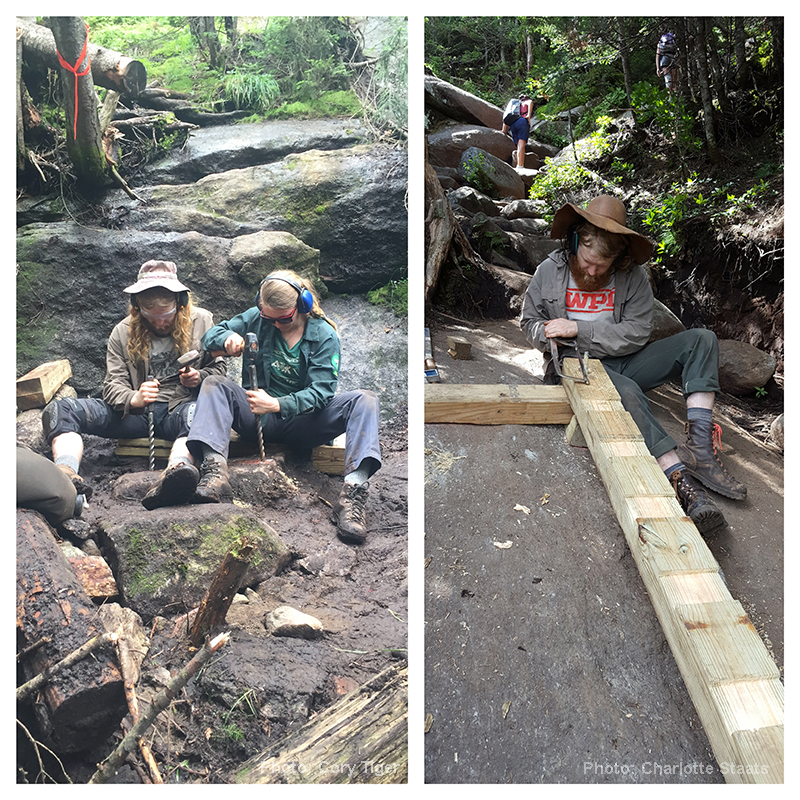 Left: Charlotte Staats and co-worker using hand-drills to drill holes into rock in order to anchor ladders to it's surface.
Left: Charlotte Staats and co-worker using hand-drills to drill holes into rock in order to anchor ladders to it's surface.
This was one of many ladders installed on Mount Colden's trail. Photo credit: Cory Tiger, 2017 Right: A trail worker uses a
hack-saw in the process of building ladders on the trail up Big Slide Mountain.
Volunteer Crews
While I spent a majority of my time working on the professional trail crew, I also spent a summer leading volunteer trail work trips. Volunteer crews are an amazing opportunity to give back to the trails that we all love and learn how trail work is done. Volunteer trail crew leaders teach participants the basic skills required for doing trail work, how to use tools safely, and the process for building trail infrastructure. A volunteer trail experience emphasizes education and skill building, which makes for a more relaxed pace of work. An experienced leader will be able to teach and oversee volunteers in the process of creating trail infrastructure, while ensuring that work is still produced to a high standard. While volunteer trail crew work allows for far more work to get done with limited trail stewardship budgets, professional trail crews are essential to the long-term viability of our trail networks. When the difficult tasks requiring skilled labor need to get done in an efficient manner, there is no replacement for a team of experienced professional trail crew workers.
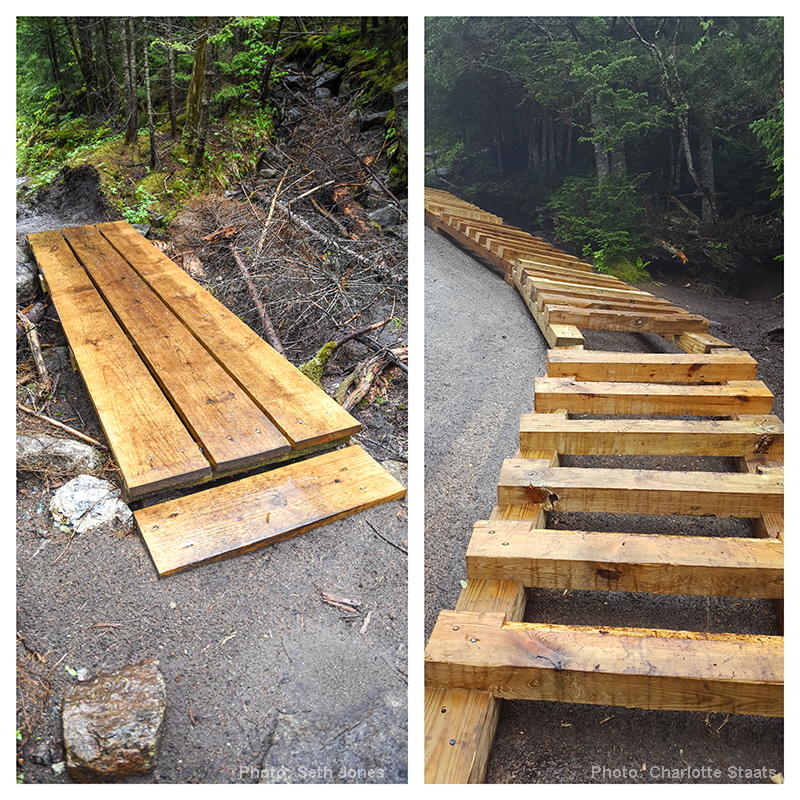 Left: An example of a small span bridge built with dimensional lumber. Photo credit: Seth Jones, 2017
Left: An example of a small span bridge built with dimensional lumber. Photo credit: Seth Jones, 2017
Right: The finished ladders built by my crew on the trail up Big Slide Mountain
The End of the Day
The end of a workday gives way for time to enjoy being where you are. On my way to camp, my body weary from working hard, I always found time to stop for a moment to look around and absorb my surroundings. Even if it had rained all day, or the black flies had mercilessly swarmed me until I couldn’t see straight, I was always able to take a deep breath and feel a warm glow of happiness within me for being able to work in such naturally breathtaking places. While eating dinner with my crew or laying down in my tent, my mind would wander and I would think about the Adirondacks and what I had seen while in different regions. In the sparse minutes before I slipped into a deep slumber, I would think about the unique challenges that regions of the Adirondack park face, and that’s what my next blog entry will discuss.

Charlotte Staats is the Adirondack Council’s Clarence Petty Advocacy Intern for the 2020 legislative session. She grew up in Westport, New York, and graduated from Clarkson University in 2017 with a Bachelor of Science in Environmental Science and Policy. For the past five years, Charlotte worked on a professional trail crew, building and maintaining hiking, skiing, mountain biking, and snowshoe trails throughout the Adirondack Park.




